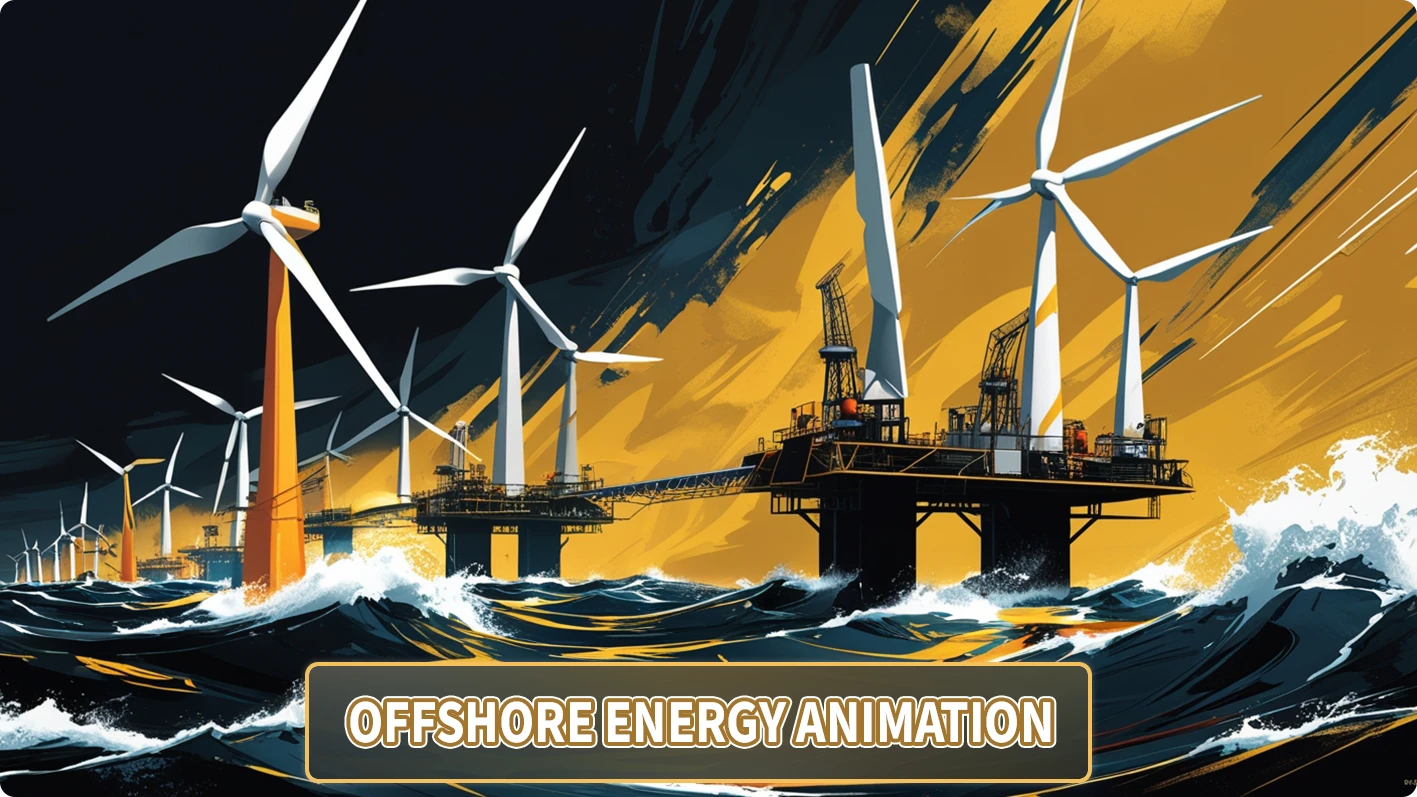Offshore energy animations are a powerful example that refers to the creation of moving images to display processes, equipment and operations related to energy production in offshore environments, such as oil and gas exploration and extraction, installation of offshore wind turbines or wave energy generation systems. Which are used for training, simulation, advertising and documentation in the offshore energy industry, including oil, gas and renewable energies such as wind and wave. These animations are created using two-dimensional (2D), three-dimensional (3D), motion graphics or whiteboard techniques that play a key role in education, marketing and… by displaying complex processes, advanced equipment and technical concepts in a simple and understandable way.

What are the types of offshore energy animations?
Offshore energy animations come in different styles, techniques, and applications, which we will explore below:
- 2D animation: This type of animation is used to demonstrate offshore energy processes in a simple and understandable way, such as how pumps, piping systems, or safety protocols work, and is low-cost and fast to produce. This type of animation is common in education and advertising.
- 3D animation: 3D animation is used to accurately and realistically simulate complex operations such as deep water drilling, jacket installation, or offshore wind turbines. This style is popular in investor presentations and project documentation due to its high visual quality and detailed presentation.
- Motion Graphics: Motion graphics are used to present statistical information, introduce offshore company services, or display data related to energy production. This style includes moving graphics, charts, and texts that convey information in a simple and attractive way. This type of animation is used in advertising for contracting companies, annual reports, and social media content.
- Whiteboard Animation: Whiteboard animation is used to teach basic concepts, such as oil exploration processes or the environmental impacts of offshore energy. This style is suitable for non-specialist audiences due to its simplicity and attractiveness. This animation is used in educational videos, customer presentations, and digital content, and is low-cost and understandable for everyone.
- Stop-motion Animation: This animation is less used in the offshore energy industry. Stop-motion animation can be used for creative projects or to display physical models of equipment such as oil rigs. This animation is used in creative advertising and art projects and has a nostalgic feel and unique visual appeal.

What are the uses of offshore energy animations?
Animations have many uses in the offshore energy industry, the most important of which are as follows:
- Education and safety:
Animations are used to teach safety protocols, use of equipment and management of emergencies such as oil spills or fires on offshore platforms. For example, these animations are used in response to fire conditions and teaching safety protocols in a safe place.
- Operation simulation:
3D animations are used to demonstrate complex processes such as installing jackets, laying underwater pipes or starting offshore wind turbines and come to the aid of designers and engineers at different stages to accurately review the project.
- Advertising and Branding:
Motion graphics and 2D animations are used to introduce the services of contracting companies or to show the achievements of offshore projects. For example, producing advertising teasers to attract investment in wind energy projects.
- Presentation to investors:
High-quality animations are presented to investors to show the progress of projects or the potential of joint fields. For example, 3D animations to show the production process in FPSO vessels that investors invest with an open view and review of the project.
- Documentation and reporting:
Animations are used to document the engineering, purchasing, construction and installation processes in offshore projects. For example, these animations are used to report on the installation of transmission pipelines and…
- Environmental awareness:
Educational animations are used to demonstrate the environmental impacts of offshore projects and solutions to reduce them, such as clean technologies in wind energy. Motion graphics videos about protecting marine ecosystems are an example of such animations.
What are the benefits of using animation in offshore energy?
- Animations display technical processes such as offshore animation drilling or wind turbine installation, which are very complex and specialized, in an understandable and simple way.
- Increased safety with training in a safe environment that eliminates human error.
- Attractive visual content attracts a larger audience, increasing engagement and conversion rates.
- Animations are less expensive and save money compared to actual filming of offshore operations.
- Flexibility and the ability to show processes that are impossible to film.
Offshore energy animations are a key item for training, simulation, advertising and documentation in the offshore energy industry. From 2D animations for safety training to 3D animations for simulating complex operations, these animations increase information and productivity. Renewable3D is at your side with a team of experts and state-of-the-art equipment and technologies to design and implement quality animations based on your needs and tastes, and to target your target audience. To see our portfolio and order animations, contact our experts now.


